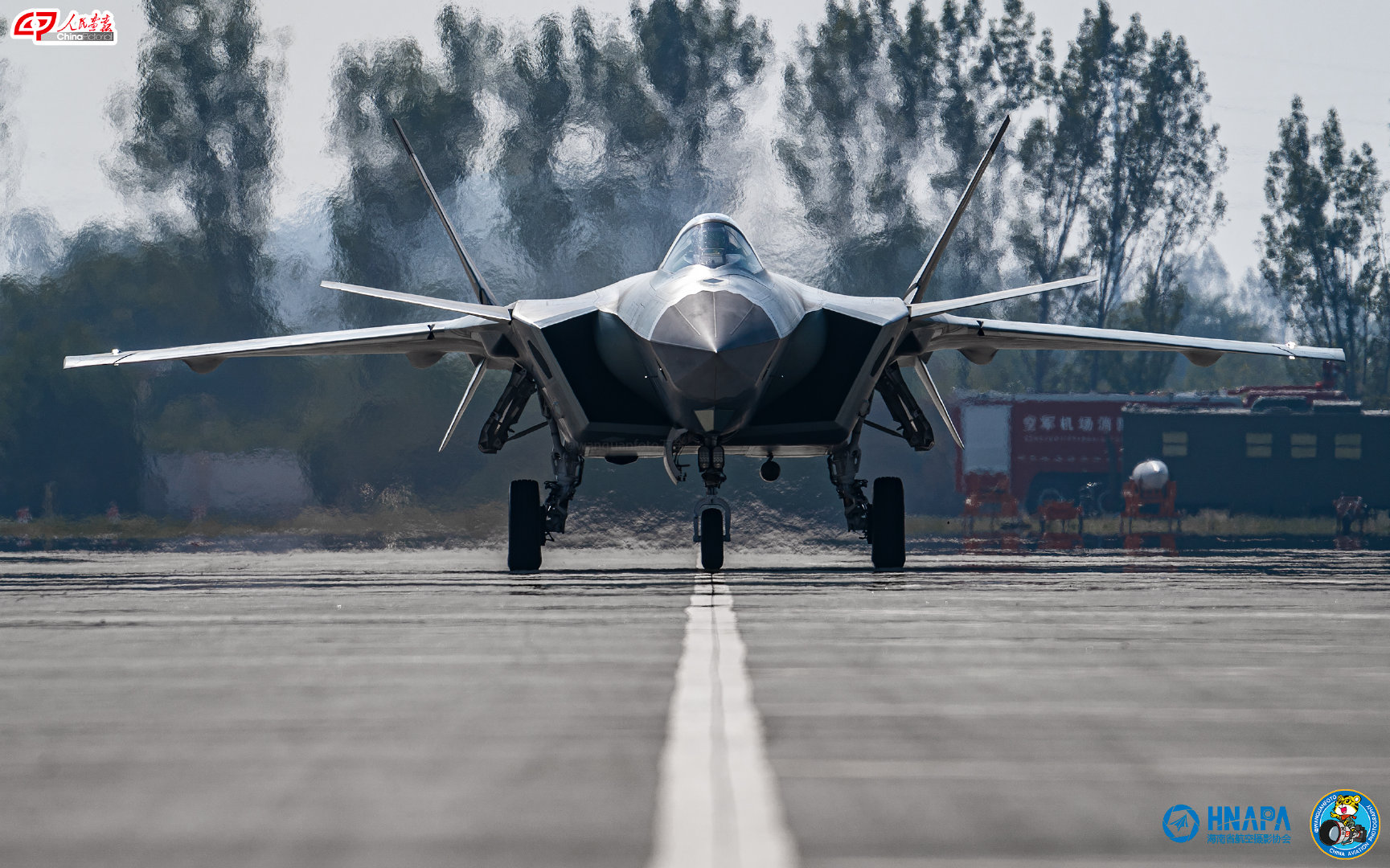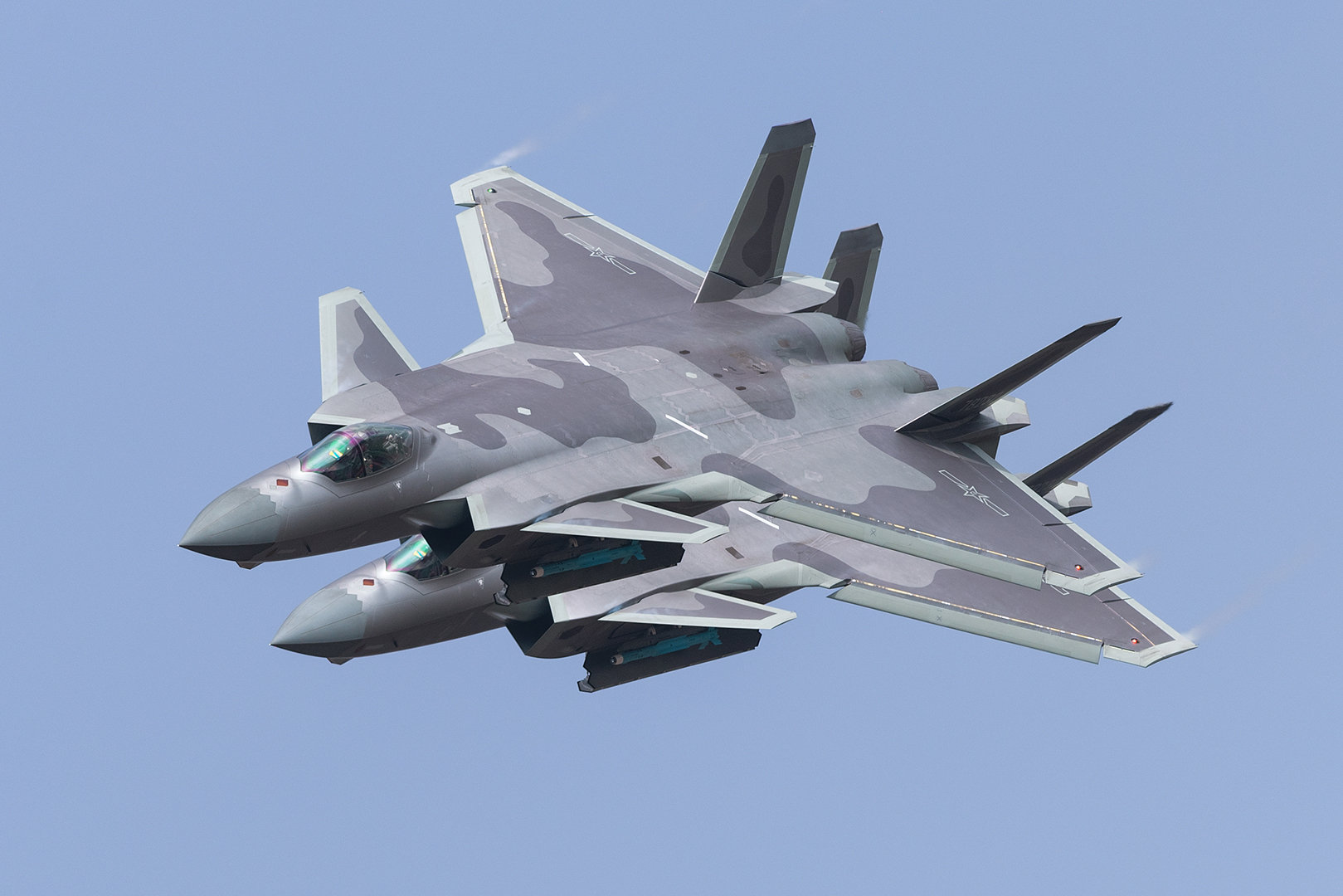You are using an out of date browser. It may not display this or other websites correctly.
You should upgrade or use an alternative browser.
You should upgrade or use an alternative browser.
J-20 5th Gen Fighter Thread VI
- Thread starter siegecrossbow
- Start date
- Status
- Not open for further replies.
Very recent (November 25, 2019) publication of "Research on impact of canard to RCS" by 611. The article seems to have been submitted in 2017.
Summary:

Summary:
- Comparison of conventional and canard configurations of otherwise the same fuselage, based on F-35.
- Before improvement on canard configuration, compared to conventional layout, Canard has
- Slightly worse RCS return in frontal area from 0 to 30 degrees because:
- Canard aft edge reflection is exposed while conventional horizontal stabilizer is blocked by main wing.
- Sharp end of aft edge of canard.
- The gap between canard and fuselage is another strong contributor, but mostly to high frequency (C band).
- Much less RCS return from the side, from 30 to 90 degrees, because conventional horizontal and vertical stabilizer forms a strong reflector while canard does not.
- Slightly worse RCS return in frontal area from 0 to 30 degrees because:
- Improvement
- Use radar absorbent structure (not paint) on all edges, the light grayish green area. It is much better than paint in terms of frequency band and size.
- Smooth curvature and seal of the inner edge of canard.
- Cut the corner of canard aft edge.
- After improvement, the conclusion is that canard configuration with proper measures is equal to conventional configuration in RCS.
- As to the "canard moving increase RCS":
- the test shows that within +- 5 degree movement (in cruising), there is both increase and also decrease (-5 degree). Overall neglect-able.
- When the canard must be turned more than 5 degrees, the aircraft is in a situation where the whole RCS has drastically increased (close dog fight or violent maneuver) making canard's contribution neglect-able or the whole stealth thing non-existent.

Last edited:
Very recent (November 25, 2019) publication of "Research on impact of canard to RCS" by 611. The article seems to have been submitted in 2017.
Summary:
It is interesting to note 2.2 where Canard configuration is inherently better than conventional on the side.
- Comparison of conventional and canard configurations of otherwise the same fuselage, based on F-35.
- Before improvement on canard configuration, compared to conventional layout, Canard has
- Slightly worse RCS return in frontal area from 0 to 30 degrees because:
- Canard aft edge reflection is exposed while conventional horizontal stabilizer is blocked by main wing.
- Sharp end of aft edge of canard.
- The gap between canard and fuselage is another strong contributor, but mostly to high frequency (C band).
- Much less RCS return from the side, from 30 to 90 degrees, because conventional horizontal and vertical stabilizer forms a strong reflector while canard does not.
- Improvement
- Use radar absorbent structure (not paint) on all edges, the light grayish green area. It is much better than paint in terms of frequency band and size.
- Smooth curvature and seal of the inner edge of canard.
- Cut the corner of canard aft edge.
- After improvement, the conclusion is that canard configuration with proper measures is equal to conventional configuration in RCS.
- As to the "canard moving increase RCS":
- the test shows that within +- 5 degree movement (in cruising), there is both increase and also decrease (-5 degree). Overall neglect-able.
- When the canard must be turned more than 5 degrees, the aircraft is in a situation where the whole RCS has drastically increased (close dog fight or violent maneuver) making canard's contribution neglect-able or the whole stealth thing non-existent.
View attachment 55945
Interesting that we are promoting a study of canards and conventional tail RCS based on the F-35 fuselage, showing that RCS is better from the side with the canard because of the strong reflector created by the horizontal and vertical fin junctures.....in order to affirm the use of canards on the J-20
So from this they draw the conclusion that canards may be inherently better than conventional tails on an F-35, what they ignore is that with the additional lift of canards on the forward fuselage, they would need to move the main wing aft in order to maintain the center of lift near the center of gravity, and doing this they would likely create a similar reflector of the main wing and vertical stabilizers?
IMHO this ignores the even stronger RCS reflector created by the vertical tails and ventral fins with the main wing on the J-20??
I would suggest that the F-35 has less of an RCS spike aft with the verts and horizontal stabilizer, than the J-20 does with the verticals and ventral fins??
the study does accurately conclude that angles and sharply angled tips do indeed spike RCS return
Brumby
Major
Interesting that we are promoting a study of canards and conventional tail RCS based on the F-35 fuselage, showing that RCS is better from the side with the canard because of the strong reflector created by the horizontal and vertical fin junctures.....in order to affirm the use of canards on the J-20
I had the same impression initially and maybe i thought it is some typo error between J-20 and F-35. If the aim is to affirm the use of canards on the J-20, it has the attributes of a strawman logic in approach. I would love to see the study published using the J-20 as the primary platform of interest and not on the F-35 which does not it. That would probably be a one way ticket to the "Gulag"..
Can’t say this by definite, but I think even if they were post a paper with j-20, the conclusion would be still the same.I had the same impression initially and maybe i thought it is some typo error between J-20 and F-35. If the aim is to affirm the use of canards on the J-20, it has the attributes of a strawman logic in approach. I would love to see the study published using the J-20 as the primary platform of interest and not on the F-35 which does not it. That would probably be a one way ticket to the "Gulag"..
This is a very common practice in academic when certain part of your content or data is keep in secret, then using a public database or a module would be the ‘go to’ method for publishing your achievement.
Brumby
Major
Can you outline your reasoning to support your view that the conclusion will still be the same.Can’t say this by definite, but I think even if they were post a paper with j-20, the conclusion would be still the same.
This is a very common practice in academic when certain part of your content or data is keep in secret, then using a public database or a module would be the ‘go to’ method for publishing your achievement.
As with everything especially in academic, the devil is in the details. If you are presenting a module as a surrogate, then you would first have to justify why your chosen module is even reasonably (logically) and necessarily (empirically) sound.
I still recall somewhere that there was a source stating that the J-20 canards were radar transparent to -30 dBsm, i.e, limiting the airframe to that dBsm rating. Unfortunately, I haven't been able to find it, and I was hoping this paper would give corroborating evidence of the stealth level.
In other news, I don't think the direct link was included, so...
In other news, I don't think the direct link was included, so...
Can you outline your reasoning to support your view that the conclusion will still be the same.
As with everything especially in academic, the devil is in the details. If you are presenting a module as a surrogate, then you would first have to justify why your chosen module is even reasonably (logically) and necessarily (empirically) sound.
Well, in certain way, I think you misunderstood about what they did and what they trying to achieve.
Let‘s look at the scenario here.
Firstly, I agree the general purpose of this paper may affiliate rcs impact over the j-20 canards, cause f-35 with canards just mean less because there is no such thing. And they might did the experiment on J-20 in the first place.
After they did the experiment and testing, they found, in general, canards with certain improvements could match the rcs performance of a conventional layout. But due to whatever reason, they realize the publish the original data on j-20 is sensitive or they have to through a lot extra efforts in order to do so.
So instead, they build a model for a fictional f-35, and redid the experiments and tests on that, and write a paper about it. Since this particular aircraft is not Chinese, it’s not real, so no secret involved, no clearance needed.
You see, the idea here is to publish the finding and method without specifying the data they use, as long as the conclusion is the same, they could live with the fact, that the real j-20 results may have slight differences, but hi, I don’t think they will disclose those data any time soon, in fact if you ask them, they may as well deny the connection between this paper to j-20.
Overall, the title of this paper is called “Study of canards impacts on rcs”, our guess is based on their background, but as an academic, when publishing a paper, their no.1 job is to get the paper published with the correct conclusion, the rest are all interchangeable.
Brumby
Major
I still recall somewhere that there was a source stating that the J-20 canards were radar transparent to -30 dBsm, i.e, limiting the airframe to that dBsm rating. Unfortunately, I haven't been able to find it, and I was hoping this paper would give corroborating evidence of the stealth level.
In other news, I don't think the direct link was included, so...
The preamble on that report says it all "There are so many affect factors about the fighter stealth design". In other words, the individual parts and their sum are not necessarily the same.
The preamble on that report says it all "There are so many affect factors about the fighter stealth design". In other words, the individual parts and their sum are not necessarily the same.
The result I'm getting from the paper is that the Chinese can get the RCS contribution of canards down to -50 dBsm. But their conclusion that properly designed canards impose no penalty isn't a given, as their comparison model is bizarre when compared to actual conventional stealth aircraft (F-22, F-35, although not the Su-57).
- Status
- Not open for further replies.





